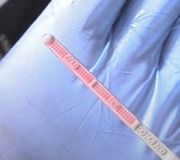Engine oil additives such as anti-foaming agents, corrosion inhibitors, detergents, and friction modifiers break down in about 3,000 miles; less if they get really hot. Cooling system additives like rust preventers and water pump lubricant break down in about two years. Coolant is alcohol and that doesn't change over time, but it is replaced every two years to get rid of the acids that normally develop.
Transmission fluid is a little different. Its additives last a lot longer. Under normal driving conditions the fluid does not need to be replaced so often. Exceptions would again be from overheating. While its main purpose is as a hydraulic fluid that transfers pressure and makes things move, it must also lubricate, (isolate moving parts from each other), and keep seals soft. Plowing snow and pulling a trailer put extra strain on the fluid in two ways. Main line pressure increases as throttle position increases. That means the pump works harder generating higher temperatures. The higher pressures are applied to the clutch packs to prevent them from slipping under the increased engine torque. Secondly, a harder-working engine transfers more power through the torque converter between the engine and transmission. That is where most of the heat is generated. To reduce the heat buildup, there is a cooler built into the radiator to transfer heat to the coolant, and almost all cars now have a "lockup torque converter" to eliminate the inherent slippage. That reduces heat buildup and improves fuel mileage. External coolers can be added too.
Chrysler was the first to develop a lockup converter and used it in 1977. I have a 1978 model and had a lot of trouble with that system. Now that it is perfected, only GM had a huge problem with the unit sticking on their '80s models front-wheel-drive cars. The solution was to unplug the electrical connector so it never activated, therefore it couldn't stick. When it did stick, it caused engine stalling at stop signs just like forgetting to push in the clutch pedal on a manual transmission.
Chrysler was also the first to use a completely computer-controlled automatic transmission starting with the 1989 models, and like anything new, they had a lot of trouble with it. By now every company has developed their own version and has gone through the same problem and learning phase. I still use a 1988 Grand Caravan to pull an enclosed trailer that's bigger than the van. I have the older non-computer-controlled transmission and the fluid and filter has only been changed once in 222,300 miles. I don't propose anyone abuse their vehicle like that, but it goes to show that transmission fluid is some really tough stuff.
A friend solved a harsh engagement problem by adding an additive to his high-mileage transmission a few years ago. He had one of the few Chrysler units that made it to 180,000 miles without needing a rebuild. Most of these additives work the same way by dissolving varnish buildup on valves and by softening hardened rubber seals. I've heard of a number of cases where people use these products, but what I haven't heard is people needing to keep adding more periodically. That would seem to indicate you can expect it to last quite a while. At 165,000 miles and 11 years old, the seals can start to get hard and won't conform to surface irregularities like they did when they were new. For proper maintenance, this additive should not be an alternative to regularly-scheduled fluid and filter changes. When that is done the next time, see how it shifts before you add more of this product. The higher-cost services are now adding a bottle of strong detergents to the fluid first to dissolve the varnish buildup, then after driving it a few miles, they completely drain the system and put in all new fluid. You might not need an additive as they include their own bottle of additive with the new fluid. The reason this high-cost service has popped up all over is because transmission problems have become very common with newer cars and people seem to think that's normal. Adding a product like you're using will address those problems related to varnish causing sticking valves, and seals that might be leaking internally. Many transmission problems are caused by broken parts. No additive is going to solve that.
Caradiodoc
Sunday, October 24th, 2010 AT 2:43 PM




